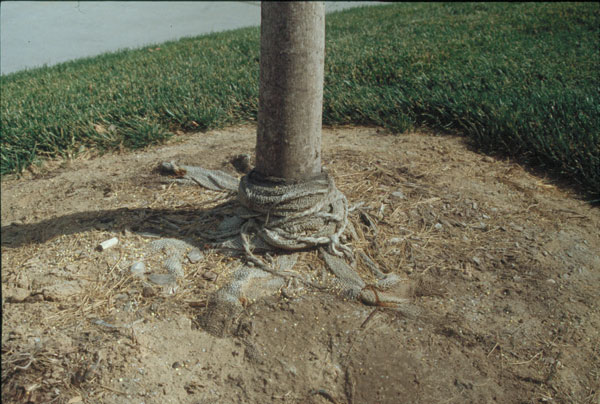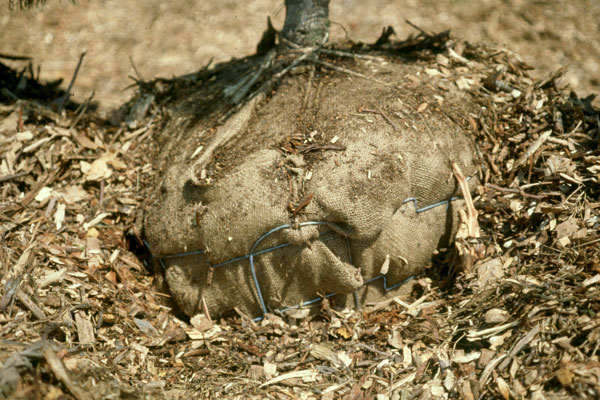Do I Remove Root Ball Packing Materials?
by Michael Kuhns, Extension Forestry Specialist, Utah State University and Brook Lee, Community Forester, Utah Division of Forestry, Fire & State Lands
Notes from Experts
U.S. Forest Service State and Private Forestry Northeastern Area says:
- For trees in wire baskets, cut and remove wire.
- Cut away strings & burlap or plastic, exposing root ball. Don't remove soil from ball.
- If tree is container grown, cut and remove container.
International Society of Arboriculture (ISA) says:
- Cut and remove the string and wire from around the trunk and top 1/3 of the root ball.
National Arbor Day Foundation says:
- After placing the tree, remove wires or mesh.
Alex Shigo in Modern Arboriculture says:
- Don't use non-biodegradable strings and other (root ball packing) materials.
- It is best to remove the string and pull back the burlap.
- It is wise to remove burlap to examine the roots, or to see if there are roots.

Dr. Larry Kuhns of Penn State University says:
- Basket and burlap must be removed.
Harris, Clark, & Matheny in Arboriculture, 3rd ed. say:
- Remove the wire from around the top 8-12" of the root ball.
- Before removing wire and rope/twine partially backfill to support root ball.
- If the root ball has broken apart ... it may not be wise to plant it.
- Fold burlap back from the trunk and the top of the root ball if the root ball is firm and fold it down to be buried when backfilling.
- If the burlap is sturdy or treated, carefully remove it or at least make large cuts in it. (MK's note: most burlap I've observed is treated and will not decay quickly, meaning that Harris et al. would recommend removal if the root ball is firm).
Dr. Gary Watson of the Morton Arboretum says:
- Remove twine, treated burlap, and wire baskets from around the upper part of the root ball after the tree is placed in the planting hole.

Brian Getzelman of Arborcare in Salt Lake City says:
- He prefers removing wire baskets entirely, though at least cut some of the wires.
- He likes all burlap removed.
Tony Dietz, Urban Forester for State Forestry in Utah says:
- Remove wire baskets and all burlap except for the very bottom of the root ball.
Randy Miller, former Urban Forester in Utah and now Pacific Corp System Forester says:
- Remove wire basket and burlap as long as the root ball stays together.
- Backfilling as you remove these materials can help hold the root ball together.
Dr. Michael Kuhns in the Journal of Arboriculture says:
- Single layers of untreated burlap are unlikely to have much negative effect on root growth from a root ball.
- Folding upper burlap layers below ground forms a burlap wad two or more layers thick that takes additional time to decay. This may form a separation layer or gap, possibly hindering root growth in the first few months after transplanting.
- Cut away upper burlap layers, rather than fold them back below ground.
- Treated burlap (the kind you're most likely to encounter) will not decay quickly (can take decades) and, though roots may grow through it, those roots may be damaged or constricted as they grow in diameter.
- Remove all treated burlap or synthetic burlap (also likely to decay slowly) from root balls at planting time.
Bill Elmendorf in the SAF Urban Forestry Working Group Newsletter, Winter 2000 says:
- For balled and burlapped (B&B) trees, the root ball should be compact and firm, not loose or cracked. Remove all synthetic burlap, the wire basket, the top third of natural burlap, tree wrap, and twine. (MK's note: remember that treated burlap is very similar to synthetic burlap).
Other Planting Notes From the Experts (Fertilization, Pruning, etc.):
Bill Elmendorf of Penn State Univ. says:
- Don't fertilize at planting. Don't fertilize until the first flush of growth takes place, and then go easy on the nitrogen. In subsequent growing seasons, fertilization should be frequent and light. Once the tree is established and healthy, it doesn't need to be fertilized.
- Don't prune at planting time, except to remove branches that are damaged or causing serious structural problems.
- Avoid staking if you can. If you must stake, use flexible bindings and wide straps. Remember to remove after one growing season.
Dr. Gary Watson of the Morton Arboretum says:
- It is unlikely that any nutrient is limiting the growth of the tree immediately after transplanting. Delay fertilization until a season or two after the tree is planted (longer for large trees).
- Research has repeatedly shown that newly planted trees do not respond to fertilization.
- Fertilizer does not enhance root development.
- I am aware of no published studies that show nutrients, including phosphorus, directly stimulating tree and shrub root growth. In fact, high soil phosphorus levels can inhibit beneficial mycorrhizal associations with roots.

